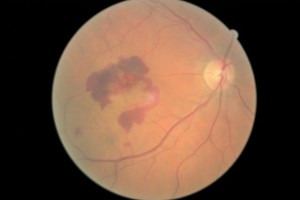Age-Related Macular Degeneration (AMD) is a chronic disease of the central part of the retina, the macula. The macula is important for clear vision and color vision. Any change in the macula will significantly impair vision. AMD is the leading cause of blindness in the Western world.
There are two forms of AMD:
Dry AMD is the most common form of AMD. It occurs when cells in the macula begin to break down, causing thinning of the macula and a gradual decrease in vision. In addition, the retina becomes unable to rid itself of its metabolic waste, called lipofuscin. Lipofuscin accumulates in the retina as drusen, which block the normal function of the retina.
Wet AMD is much less common than dry AMD. It is caused by the growth of abnormal blood vessels in the choroid, which provides the blood supply to the retina. These new blood
 vessels grow into the macula through breaks in the membrane that separates the choroid from the retina. These weak blood vessels leak fluid into the retina, leading to a decrease in vision that is more rapid and dramatic than dry AMD. The photo on the right shows an example of significant leakage and bleeding in the macular area and surrounding retina.
vessels grow into the macula through breaks in the membrane that separates the choroid from the retina. These weak blood vessels leak fluid into the retina, leading to a decrease in vision that is more rapid and dramatic than dry AMD. The photo on the right shows an example of significant leakage and bleeding in the macular area and surrounding retina.
Neither dry AMD or wet AMD causes total blindness, but it can decrease central vision profoundly. People with AMD may notice changes in their ability to read books, to see street signs or see details on a person’s face; fortunately they maintain peripheral vision and can walk and move around independently.
Symptoms of AMD:
- Gradual or rapid loss of central vision
- Distortion of straight lines
- Blurry vision when reading
- Blind spot in or near the central vision
- AMD can be asymptomatic too.
Risk Factors of AMD:
- Age
- Smoking
- Family history of AMD
- UV light exposure
- Blue light exposure (short wavelength visible light)
- Diet high in sugar and refined carbohydrates
- Excess weight or obesity
- Gender, women are at higher risk than men
- Eye color, light colored eyes have a higher risk
- Race, caucasians are at a higher risk
- Diabetes
- Cardiovascular disease
If I see changes in the macula or am concerned about risk factors, I will often recommend taking supplements with specific antioxidants, zinc and omega-3. This is not a replacement for a healthy diet. In fact, consuming the nutrients as whole foods has a beneficial effect on our bodies that a supplement cannot replicate.
Prevention through Diet:
- Foods rich in the carotenoids, lutein and zeaxanthin (brightly colored fruits and vegetables and eggs)
- Ensure diet is high in vitamin C, vitamin E, beta carotene and zinc
- Fish with high levels of omega-3 fatty acids
Non-Diet Actions:
- Stop smoking
- Wear sunglasses
- Engage in physical activity and exercise
- Have regular dilated eye examinations
Treatments:
 The treatment for dry AMD is diet and lifestyle modification.
The treatment for dry AMD is diet and lifestyle modification.
Current treatment for wet AMD is injection of anti-VEGF (vaso-endothelial growth factor) which block protein that is responsible for new and abnormal blood vessel growth.The injections slow the progression of damage and slow loss of vision. Repeated injections are necessary. The photo on the left is the same eye pictured above after a year’s worth of treatment. Central vision is significantly compromised, but treatment has protected surrounding tissue. To date the other eye has not needed any treatment but the retinologist and I are monitoring it very closely.
3 thoughts to “Age-Related Macular Degeneration (ARMD or AMD)”